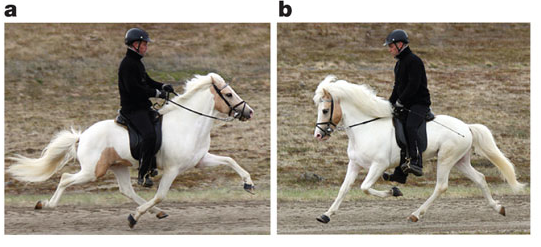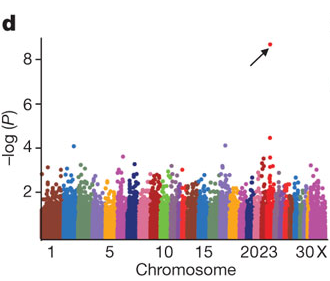Chris Peek
DMTR3 takes the lead!
Dictionary for the Equestrian Illiterate
Gait - The
specific footfall pattern, timing, and cadence with which a horse moves
Types of Natural Gaits
(in increasing speed) -The walk, the trot, and the canter/gallop. Some horses
additionally have an ambling gate and/or a pace.
Types of Alternate
Gaits
- Pace, regular rhythm ambling, lateral ambling, and diagonal ambling
Pace -
"Two-beat gait where the horse moves two legs on the same side of the body
in a synchronized, lateral movement" (Fig 1a)
Trot - Gait in
which "the diagonal front and hind legs move forward and backward
together" (Fig 1b)
Ambling gait -
"Four-beat gaits in which footfall pattern, foot placement and timing are
often unique to specific breeds"
Tölt -
"Regular ambling gait characteristic of the Icelandic horse"

Figure 1: (a) A pacing horse; fore- and
hind-legs on the same side of the body are synchronized. (b) A trotting horse; the diagonal
fore-
and
hind-legs are synchronized. (Andersson et.
al, 2012 Figure 1 permission
pending)
Journal Article: Mutations in DMRT3 affect locomotion in horses and
spinal circuit function in mice Andersson et. al
Summary: For horse-owners, the genetic factors contributing to a horse's
gait are particularly interesting. If a genetic test to screen for which horses
were more likely to take home the grand prize at a competition existed, then
horse-owners could selectively breed and train those horses destined for glory.
Through a Genome Wide Association Study (GWAS) and a knockout mouse model, a
team of Swedish scientists recently identified the gene, DMRT3, to have a major effect on a
horse's gait. The investigators first determined a chromosomal region
associated with the Gait locus
(Figure 1d). Further genome sequencing of the candidate genes in this region
revealed that DMTR3 was mutated in a
large percentage of the horses with the ability to perform alternate gaits. The
Swedish team used Dmtr3-/-
mice to evaluate the role of this protein in locomotion. These knockout mice
displayed normal motor coordination and balance, but demonstrated difficulties
when running at higher speeds, a longer stride length, increased propulsion in
all limbs, and decreased brake time in hind limbs. Heterozygous Dmtr3+/- mice did not differ from
control mice. Analysis of Dmrt3
knockout mice showed this protein is critical for the development and
configuring of the spinal circuits that control stride in vertebrates. From the
combination of genetic linkage analysis, comparative sequencing, and analysis
of a mouse knockout model, Andersson et.
al conclude that the nonsense mutation in DMRT3 is a causative mutation that
affects gaitedness in horses. This article tells a coherent story and
impressively presents a massive amount of data in a digestible manner. However,
the authors do not spend much time discussing future directions or alternative
genetic or environmental factors that might affect horse gait.


Figure 1d: Genome-wide association study
(GWAS) demonstrating significant linkage between a horse’s ability to pace and
the single nucleotide polymorphism (SNP) indicated by the arrow (SNP
BIEC2_620109) on chromosome 23.This GWAS study used 30 four-gaited (walk, tölt,
trot and gallop) Icelandic horses and 40 five- gated (walk, tölt, trot, gallop,
and pace) to determine the locus associated with the ability to pace. (1e) Schematic of region associated
with Gait locus. Shaded box
indicates minimum region of Gait locus
from linkage analysis. (Andersson et. al,
2012 Figure 1 permission pending)
Popular Press: Horses’
Ability to Pace Is Written in DNA Goldberg
Kua points out that the public understanding of science depends not just on internalizing scientific facts, but also understanding research methods and the socioeconomic impacts of scientific discoveries. Reporters communicating scientific findings to the general public should provide readers with a context to give the audience a framework within in which to interpret the results. This context should include a past body of work, the methods used to obtain the scientific results, the big picture implications of the discovery, and any notable future directions the investigators might wish to pursue. Moreover, science reporters should strive to act as an “intermediary” (effectively and accurately translating the science), a “watch-dog” (discussing the ethical implications of scientific discoveries), and “tool-givers” (adequately explaining the science, posing questions of long-term significance, and providing readers with context). Clearly, translating a scientific journal article to the layperson is no small feat and reporters often fall into several pitfalls when attempting this. These errors can include omissions, generalizations, oversimplification, and overstating the generalizability of data. Thus, with Kua’s guide on how to effectively communicate scientific literature to the general public in mind, I will critique Goldberg’s news report. (Kua, 2004).
Positives
Goldberg
does a nice job of providing a big picture. He gives the reader a historical
background of harness racing, the different types of horses, and most
importantly, the potential for this discovery to financially benefit
horse-trainers. By providing a socioeconomic context to ground the findings,
Goldberg enables the audience to understand the real-world applications of
these results. Along a similar vein, Goldberg provides a nice background for
the motivation that fueled Andersson et.
al’’s research. He says, “These [Icelandic] horses have an ambling gait
called tolt, a gait so calm for the rider that it is like sitting on a sofa…but
only some horses can pace and they [Andersson et. al] wanted to find out why.” Goldberg effectively communicates
the causative mutation that leads to a difference in horse gait, and avoids
overstating the generalizability of the research. Importantly, he notes that
this mutation “largely explained why
some horses could trot or pace and why some could not,” (emphasis added)
instead of attributing this difference to genetics alone. (Goldberg, 2013).
Negatives
Despite
providing a socioeconomic context to view the results under, Goldberg des not
provide any reference to a past scientific body of work (i.e. the known
function of Dmtr3 or previous genetic
analysis of breeding horses) or the methods the researchers used to obtain
their results. Goldberg simply states, “Scientists…recently discovered that a single
gene, which they have called DMTR3, largely explained why some horses could
trot…” He completely omits the methods the researchers used to arrive at this
conclusion. Later in the article, Goldberg commits the same error and
additionally oversimplifies the results in stating, “They found that a single
gene differentiated pacers and nonpacers.” In this statement, Goldberg omits
the fact that this gene is in fact in both types of horses, but a higher
percentage of pacers have a mutation in that gene. Another poor translation
occurs when Goldberg says, “By experimenting on mice, the Swedish researchers
next determined that these genes were held in neurons in the spinal cored,
which controls locomotion. That makes sense; trotting demands diagonal and coordinated
movements.” Here, Goldberg lumps genes and proteins as one entity and reduces
the battery of knockout mice experiments to two sentences. He fails to
communicate how the researchers used mice to determine the location and
function of the protein (not the gene as Goldberg indicates).
Conclusions
In
summary, while Goldberg does a nice job providing a larger fame of real-world
application for Andersson et. al'’s research, he does
not provide a scientific context of previous work or detail how the researchers
made these discoveries. Below is a review of how well Goldberg filled Kua’s
recommended roles as “intermediary”, “watch-dog”, and “tool-giver”.
Intermediary:
The job of an intermediary is to provide the reader with an effective
translation of the research. Goldberg’s article contains several scientific
errors (i.e. confusing the gene with the protein), thus weakening its power as
a translation. Still, Goldberg adequately communicates the researcher’s main
point – that DMTR3 predisposes horses
to have multiple gaits. Overall, Goldberg does an average job as an
intermediary between scientific research and the general public.
Watchdog:
According to Kua, the primary role of the watchdog is to discuss the social and
ethical implications of a finding. While Goldberg does a very good job
commenting on the potential for this discovery to affect horse owners, he does
not comment on ethically moral extension of these findings to human athletes –
whether or not to pigeonhole someone’s future based on a genetic test. In doing
so, Goldberg could have mentioned the other factors contributing to a horse’s
success such as training and environment. Overall, Goldberg does a below
average job of acting as a watchdog.
Tool-giver:
A tool giver should provide the reader with enough context for them to think
critically about a scientific finding and make connections between past,
present, and future research. Although Goldberg provides his audience with a
socioeconomic background of the real-world applications for this research, he
fails at providing context on every other level. He does not mention any
previous work that would act as a platform for this research, nor does he
provide the methodology that the scientists used to come to their conclusions.
Instead, he states that DMTR3 causes
differences in a horse’s gait as if it was already an established fact.
Furthermore, Goldberg does not provide the readers with any future questions
the investigators might have about Dmtr3.
Overall, Goldberg does a poor job at providing the reader with the necessary
tools to think critically about the scientific findings.
References
Andersson, Lisa, Molly McCue, Jessica Petersen, Freyja Imsland, Martin
Larhammar, Fatima Memic, Hanna Wootz, Doreen Schwochow, Carl-Johan Rubin,
Kalicharan Patra, Thorvaldur Arnason, Lisbeth Wellbring, James Mickelson, Goran
Hjalm, Klas Kullander, Gus Cothran, Nadav Ahituv, Lars Roepstorff, Sofia Mikko,
Anna Vallstedt, Gabriella Lindgren, and Leif Andersson. "Mutations in
DMRT3 affect locomotion in horses and spinal circuit function in mice.."
Nature 488.7413 (2012): 642-646. Web. Jan. 2013. <http://www.nature.com/nature/journal/v488/n7413/full/nature11399.html?WT.ec_id=NATURE-20120830>.
Goldberg,
Ryan. "Ability to Pace Is Written in DNA Of Some Horses." The New
York Times. The New York Times, 11 Sept. 2012. Web. 27 Jan. 2013. <http://www.nytimes.com/2012/09/11/sports/scientists-find-gene-could-explain-horses-ability-to-pace.html?_r=0>.
Kua, Eunice, Michael Reder, and Martha Grossel. "Science in the News: A
Study of Reporting Genomics." Public Understanding of Science 13.3 (2004):
309-322. Print.
This web page was produced as an assignment for an undergraduate
course at Davidson College.
Genomics Page
Biology Home Page
©
Copyright 2013 Department of Biology, Davidson College, Davidson, NC 28035